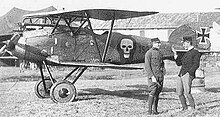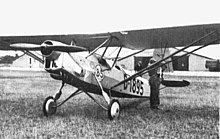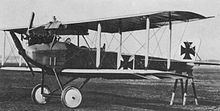Albatros Flugzeugwerke
| Albatros Flugzeugwerke GmbH | |
|---|---|
| legal form | Company with limited liability |
| founding | December 29, 1909 (as Albatros-Werke GmbH ) |
| resolution | September 1931 |
| Reason for dissolution | Forced merger with Focke-Wulf-Flugzeugbau AG to form Focke-Wulf-Albatros |
| Seat | Johannisthal airfield in Johannisthal (from 1920 Berlin, Treptow district ) |
| management |
|
| Number of employees |
|
| Branch | Aircraft manufacturer |


The Albatros aircraft plants GmbH in Johannisthal airfield in Johannisthal (from 1920 Berlin district of Treptow ) developed and built mainly during the First World War aircraft for the Air Force of the German Army .
history
Established in 1909
The company, founded on December 29, 1909 by Enno Walther Huth (1875–1964) and Otto Wiener (1873–1941) as Albatros-Werke GmbH , initially imported three French aircraft in the winter of 1909/1910; One and two-seat Antoinette monoplane and a Farman III double-decker. At the first international air show in August 1909, the Grande Semaine d'Aviation de la Champagne , the long-haul price was flown with the Farman machine and the high price with the Antoinette. These machines were used as training aircraft and as samples for license replicas in the Albatross factories. In addition to the Antoinette and Farman types, the three most famous Albatros replicas were the French summer double-decker . All machines were flown successfully and used in student pilot training. The Farman machine imported from France by the Albatroswerke was sold to the Army Administration on December 18, 1910 , after it had already been loaned for military pilot training in Döberitz . It was the first German military aircraft under the army designation "B 1". Among the five other “flying machines” that were acquired by the German army administration at the end of 1910 were two French types, a Farman and a summer biplane, which were replicated by Albatros. In 1911, further important development steps followed with the first in-house design, the MZ 1 double pigeon, and with Benno König's victory on Albatros-Farman in the Germany flight.
During the year 1912 five Albatros F-2 were built, an evolution of the French Farman III -Doppeldeckers (hence the letter F) with gondola for the crew and Argus -Reihenmotor instead of the original Gnôme - rotary engine . Four machines were delivered to the newly established Bulgarian aircraft department, where they took part in the Balkan Wars of 1912–1913. One of them flew the first military operation in the skies over Europe on October 16, 1912.
Designers Heinkel and Thelen
After Ernst Heinkel , who worked as chief designer from 1912 to 1914, was hired, from 1913 onwards, significant in-house designs in the form of two-seater bombers and reconnaissance planes followed , while Robert Thelen produced equally important single-seater fighter aircraft.
In April 1914 the subsidiary Ostdeutsche Albatros-Werke was founded in Schneidemühl ( Province of Posen ) and in September 1916 a small manufacturing facility for gliders was founded in the rural community of Friedrichshagen (from 1920 Berlin, Köpenick district ).
Albatros became known because they built some of the best known and best fighter aircraft of the First World War for the German Air Force, such as the Albatros D.III or the Albatros DV . At the beginning of the war the number of employees was 830, in November 1918 it was over 5,000. By the end of 1918, more than 10,300 aircraft had been built.
Forced fusion with Focke-Wulf in 1931
After the First World War, Albatros continued his work in the main plant, initially under chief designer Rudolf Schubert , and from 1926 under Walter Blume after the war. In 1924 the single-seat L 59 sports aircraft was created, a cantilevered low-wing aircraft made of wood with a five- cylinder Siemens & Halske Sh 4 radial engine and an output of 45 kW. Only one example was built, which was followed in the same year by the two-seater L 60 with the Sh 5 (62 kW) and L 66 or L 66a. In 1925, only 150 employees left the L 67 light aircraft and the L 68 school double-decker designed and built on the basis of the B.II. Later only the L 82 and L 101 were added in significant numbers. As a result of the global economic crisis, the Albatros' state subsidies were canceled and the company became illiquid. Under pressure from the state, Albatros merged with Focke-Wulf-Flugzeugbau AG in September 1931 . For a short time the entire company was called Focke-Wulf-Albatros .
Planes
During the First World War alone, Albatros built the following machines:
1914

- Albatros BI (type L 1), reconnaissance aircraft
- Albatros W.1 , reconnaissance aircraft ( seaplane )
- Albatros B.II (Type L 2), unarmed reconnaissance aircraft (became the standard training aircraft from 1915)
1915
- Albatros B.III (Type L 5), reconnaissance aircraft
- Albatros B (K351B), water training aircraft
- Albatros CI (type L 6), reconnaissance aircraft
- Albatros C.III (Type L 10), reconnaissance aircraft
- Albatros C.Ia (type L 6), reconnaissance
1916
- Albatros DI , hunter
- Albatros D.II , hunter
- Albatros D.IV , hunter (prototype)
- Albatros GI , bomber (prototype)
- Albatros G.II , bomber (prototype)
- Albatros G.III , bomber
- Albatros W.4 , Jäger ( seaplane )
1917

- Albatros C.IX , scout
- Albatros CX , scout
- Albatros L 30 , standard training aircraft
- Albatros D.III , hunter
- Albatros DV , single-seat fighter
- Albatros D.VII , experimental aircraft
- Albatros Dr.I , experimental aircraft (fighter)
1918

- Albatros C.XII , scout
- Albatros C.XIII
- Albatros DX , experimental aircraft (fighter)
- Albatros C.XIV , scout
- Albatros C.XV , scout
- Albatros D.XI , experimental aircraft (fighter)
- Albatros D.XII , experimental aircraft (fighter)
- Albatros D.VI , experimental aircraft (fighter)
- Albatros D.IX , experimental aircraft (fighter)
- Albatros Dr II , experimental aircraft (fighter)
- Albatros JI , attack aircraft
- Albatros J.II , attack aircraft
Machines built later were:
1922
- Albatros L 57 , airliner
1923
- Albatros L 58 , airliner
1924
- Albatros L 59 , sports aircraft, self-supporting low-wing aircraft in wood construction with five-cylinder radial engine Siemens Sh 4 with 45 kW output, one copy built
- Albatros L 60 , sports aircraft, 600 kg variant of the L 59 with seven-cylinder Siemens Sh 5 radial engine with 62 kW, three copies built
- Albatros L 66 , sports aircraft, two-seater, stripped high-wing aircraft in mixed construction with two-cylinder Haacke HFM 2a boxer engine with 25 kW output, L 66a with different landing gear and different engines
1925

- Albatros L 67 , light aircraft, two single-seater braced high-wing aircraft in timber construction with the Bristol Cherub (22 kW) or Anzani (37 kW) engines
- Albatros L 68 , school double-decker with wings made of wood, spars made of duraluminium, a tubular steel fuselage with fabric covering and a seven-cylinder Sh 11 radial engine with 71 kW output
- Albatros L 69 , cantilever high-decker in wood construction and three-cylinder radial engine Bristol Lucifer with 74 kW output or Siemens Sh 12 with 92 kW, length 6.08 m, height 2.64 m, wingspan 8.06 m
1926
- Albatros (DVL) H.1 , altitude test aircraft, biplane, Sh.III , 118 kW
- Albatros L 68a , b, c, d, e, school double-decker, variants of the L 68 with a more powerful Sh-12 engine (92 kW)
- Albatros L 71 , school biplane, unrestrained single-handled biplane with offset wings and pusher propeller, two pieces built
- Albatros L 72 , transport aircraft for Ullstein Verlag
- Albatros L 73 , airliner
1928

- Albatros L 74 , trainer aircraft
- Albatros L 75 , airliner
- Albatros L 82 , 82a, 82b, 82c, biplane sports aircraft in mixed construction with N-handle, folding wings and open seats, a total of 17 pieces built (an 82a with a 74 kW engine de Havilland Gipsy, an 82b with a 59 kW five-cylinder Sh 13 and 15 82c with 81 kW with seven-cylinder radial engine Sh 14 )
1930

- Albatros L 100 , sport aircraft, low-wing aircraft with three-seater cabin and Argus-As-8 engine with 70 kW, one piece built
- Albatros L 101 , sport aircraft, two-seater high-wing aircraft with fabric-covered duraluminum wings, tubular steel fuselage and Argus-As-8 engine, 75 copies built
1931
- Albatros L 102 , sport aircraft, enlarged L 101 with the Argus As 10 C-1 engine with an output of 147 kW
literature
- Enzo Angelucci, Paolo Matricardi: Airplanes from the beginning to the 1st World War. Wiesbaden 1976, ISBN 3-8068-0391-9 .
- John F. Connors: Albatros Fighters in Action. Carrollton 1981, ISBN 0-89747-115-6 .
- Günter Kroschel, Helmut Stützer: The German military aircraft 1910-18. Lohse-Eissing, Wilhelmshaven 1977, ISBN 3-920602-18-8 .
- Kenneth Munson: Bomber 1914-1919. Patrol and reconnaissance aircraft. Orell Füssli, Zurich 1968.
- Kenneth Munson: Warplanes, fighters and training aircraft 1914-19. Zurich 1968.
- Heinz J. Nowarra : The Development of Airplanes 1914-18. Munich 1959.
- Peter Schiemer: The Albatros (Oeffag) fighter planes of the kuk aviation troops. Weishaupt Verlag, Graz
- Günter Schmitt: When the vintage cars flew - the history of the Johannisthal airfield . Transpress, Berlin 1980, ISBN 3-344-00129-9 .
Web links
Individual evidence
- ↑ Dieter HM Gröschel, Peter M. Grosz: Career and Misery of the Dipl.-Ing. Otto Wiener from the Albatroswerke. Bad Reichenhall 2010.
- ↑ a b When the oldtimers flew , p. 77ff.
- ↑ When the oldtimers flew , p. 79ff.
- ↑ When the classic cars flew , p. 160.
- ↑ Aviation . Volume II, No. 22, November 17, 1910, p. 724.
- ↑ MZ stands for military two-decker
- ^ I. Borislavov, R. Kirilov: The Bulgarian aircraft. Volume I: From Bleriot to Messerschmitt . Litera Prima, Sofia 1996. (Bulgarian)
- ↑ The last albatrosses - In the atmosphere of the Reichswehr. In: FliegerRevue. July 2009, pp. 58-61.
- ↑ Hartmut Pophanken, Klaus Schalipp, Peter Kuckuk: A century of air and space travel in Bremen: From the earliest flight attempts to the Airbus and the Ariane . Bremen 2015, Edition Falkenberg, p. 80, ISBN 978-3954940714
- ^ Book review in the Austrian Aviation Archives, issue 4/84, accessed on October 29, 2010.




